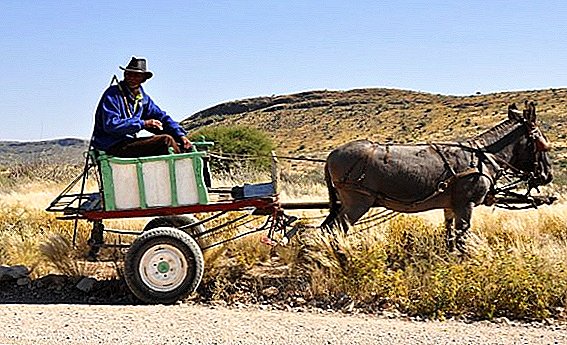
Those who have sheep know for sure that breeding these animals is a very profitable occupation.
If you have a sheep, then you will regularly receive dairy and meat products, wool.
The benefit will increase if, in addition to the sheep, to breed and young.
It can be sold or left in your own yard, increasing the number of cattle.
You need to know all the features of pregnancy of sheep, especially if you come across this process for the first time.
In order to inseminate a flock of sheep, you need 2 - 3 good two, three or four year old sheep. They will be enough for all the sheep from the flock to become pregnant.
Sheep can only be inseminated when it has reached the age of one. In this case, the pregnancy will be calm, and the likelihood of complications will be low.
The sheep must be healthy and well-fed enough to bear the offspring. On average, the period of carrying the fetus in a sheep is delayed for 5 months, but there have been cases when the pregnancy lasted 142-156 days. A pregnant sheep needs constant care and proper diet.
Do not give pregnant female food that can ferment in the stomach.

In order to avoid complications during pregnancy, you need to follow the recommendations in terms of feeding.
For example, in the summer of a pregnant sheep there will be enough grass to eat on the paddock, but in the evening it will need to be slightly nourished with bran, meal, feed or grain grinding.
In winter, the grass in the diet should be replaced with hay, and top dressing remains the same. One sheep will be enough 350-400 g of feeding.

The most common question that is associated with pregnancy in a sheep is how to determine this very pregnancy.
If the animal does not have another heat, then this is the surest and first sign that the sheep is carrying the fruit.
If the cattle became pregnant, then it becomes calmer than before. You can also try to feel the fetus with your hand, that you can notice something only 2 months after the embryo begins to develop.
It is necessary to palpate the sheep carefully so as not to harm the fetus. To do this, put the animal in front of you and try to feel the fetus through the abdominal wall. It is necessary to guide the fingers from the edges to the center, so that, as a result, they will close.
In order not to confuse the embryo with the stomach, two days before this, the sheep must either not be fed at all, or only liquid feed should be given.
It is best to conduct the mating in November. Then the lamb will be born when it is warm. Due to this, you can significantly save on the room and childbirth.
Stages of pregnancy

If a sheep gives birth in 1 to 2 days, then its udder will increase in volume due to filling with milk. The ligaments in the pelvic region become more relaxed, and the pelvic part itself falls.
The tail thickens, becomes softer, and the skin under it seems to be inflamed, that is, there is redness and swelling.
The less time is left before the lamb is born, the more restless the sheep lead. She tries to retire, stops eating. As soon as such changes in behavior are noticeable, a pregnant sheep should either be allocated a separate blocked corner in the common room, or transferred to a special separate room.
As soon as the sheep is alone, she will begin to inspect the territory, walk along the walls, sniffing them. As soon as the brute begins to be bred in the litter, this means that the childbirth has begun. Sheep will rise, lie down, and so several times.

Opening of the uterine mouth

In this phase, a bubble opens in which the fetus is contained. The sheep begins to move the fallopian pharynx during labor. In this way, the birth canal expands, into which the fetus enters along with the amniotic membrane.
This process is delayed for 1 - 2 hours. At this time, the intensity of contractions increases, and the time between them decreases.
Udder and skin under the tail swells up and reddens. After the next fights there should be a bubble with a lamb.
This bubble should burst, and from it the amniotic fluid will come out, which the sheep will lick off. If the bubble itself has not burst, it must be broken, otherwise the fruit will suffocate. It is important to remember that this bubble should burst before it comes out.
Expulsion of the fetus
At this time, the muscles of the uterus and abdomen contract so that the lamb comes to light. Expelling a fetus can take from 5 to 50 minutes.
When the bubble bursts, you can see the kid himself. In the intervals between contractions, a sheep can rise to its feet, sniff the litter, lick the amniotic fluid that appeared after the bubble burst.
Contractions are becoming more frequent, due to which the lamb and goes feet first. If at this time there are difficulties due to the fact that the legs can not get out, you need to help the sheep, gently pulling the fruit.
It is best to entrust this business to the vet. But if everything goes well, and the legs fell out by themselves, then the lamb will come out on its own at once, and the umbilical cord will tear. If the gap did not occur, then the umbilical cord should be cut at a distance of 10 cm from the belly of the newborn.
The ewe will start licking its lamb, freeing the baby's airways from mucus. The mother’s whole body will lick the child dry. In no case should this first contact be interrupted, since after that the sheep will always find its lamb by smell.
Birth of lambs

After 10-45 minutes after the release of the first lamb, a second one should appear after it.
This process takes a little time due to the fact that the birth canal is already open.
As soon as the sheep gets on its feet and again starts digging into the litter, this signals the exit of the second baby.
She will give birth to him standing up, while the lamb will fall on its own on a soft mat.
Also interesting to read about the construction of a goat barn
Care immediately after delivery
After the lambs come out, the placenta and the remnants of the shell must leave the uterus. After 5 - 6 hours, the afterbirth will be released. He has to go out on his own.
Otherwise, the sheep may have blood poisoning, so a veterinarian should be called.
It is necessary to clean the afterbirth from the sheep for 1 - 2 hours. It is also necessary to remove the litter, which must be prikopat along with the afterbirth. For the latter to go faster, the sheep should be given to drink warm water.
Before letting the lambs stick to the udder, it must be cleaned. If there are any lumps on the scalp of the mammary gland, they must be carefully cut.
Wash the udder only need warm water mixed with soda. After washing, the gland should be wiped with a clean cloth to dryness. Also to be cleaned and the place where lambing occurred.
After the birth of the lambs, they themselves find an udder, and if the sheep had lambing before, then it will help the young. The first few days after birth, babies will sleep a lot, if they are full.
Sheep lambing should be carefully monitored to prevent the death of both the mother and the lambs.












